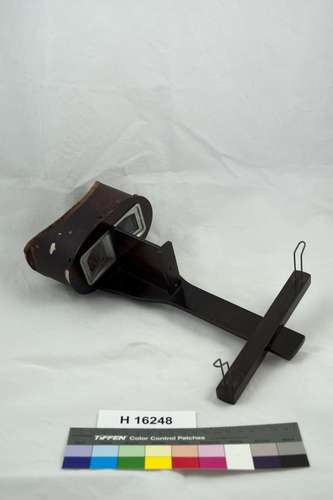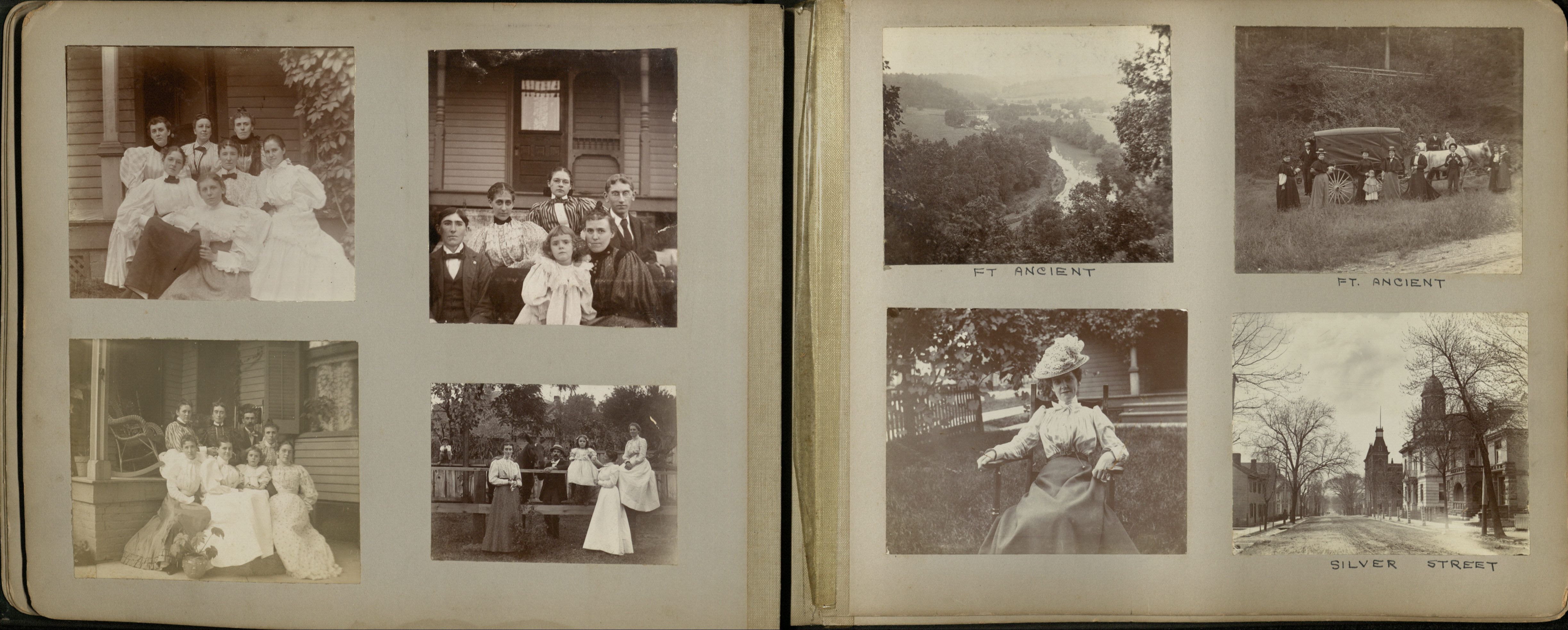Have you ever seen a stereoview? If not, maybe you grew up playing with a very similar technology- the View-Master. Imagine seeing these magical 3-D images in the late 1800s!
Before television and movies hit the scene, many Ohioans embraced the idea of three-dimensional images through the use of the stereoview. When first looking at a stereoview card, it can be a little confusing. Why would a photographer place two copies of the same photograph on a card together?
It turns out, you need the right technology for this card to make sense. When looking at a stereoview card through a stereoscope (as seen below), the two images become one image that feels three-dimensional to the viewer.

So is the stereoscope magical? Not quite. The science behind the stereoscope comes from the basics of human vision. Sir Charles Wheatstone, a scientist of the 1830s, was the first to popularize this idea of binocular vision. When we look at an object (for example the computer, cell phone, or tablet you are reading this on) each eye receives a slightly different image. The brain combines these two images to make the object three-dimensional.[1]
This article describes Wheatstone’s concepts well.
By the 1850s, Sir David Brewster improved upon Wheatstone’s ideas, producing a commercially popular stereoscope that used lenses to replicate the distance between the eyes. When you view a stereoview card through a stereoscope, the system of lenses allows your right eye to see only the right image and vice versa. The brain processes these two simultaneous views as a three-dimensional image.[2]
Fortunately Wheatstone and Brewster’s ideas appeared around the same time that eager photographers were quickly developing their own art. Photographs were the perfect images to be used in the newly developed stereoscope as they are more precise than drawings.[3]
Unfortunately the earliest photographic method, the daguerreotype, produced only one single print from each exposure. There was no negative, and therefore multiple prints could not be made and sold. Quickly, photographers developed the technology to create a negative image that could be reproduced many times. Now a photographer could capture a stereoview scene once, but sell it again and again.[4]
Many photographers created stereoviews by moving their camera a few inches between two exposures to replicate the distance between the right and left eye. This is likely the reason that many stereoviews represent static scenes such as buildings or nature. Unlike people, these scenes would not move and change between exposure times. A stereoscopic camera was developed around the 1860s to help the photographer get both necessary images in one shot.[5]
As stereoviews developed, so did the stereoscope. With his handheld stereoscope design (1859), Oliver Wendell Holmes made it easy for many Victorian era families to enjoy stereoviews at home.[6]
Stereoviews remained a common feature in Ohioians’ homes from their early popularity in the United States in the 1860s through their decline in the 1920s. Due to quick changes in technology, including motion pictures, interest in stereoviews very quickly waned.
However collectors, most notably Dr. Brian May of the rock band Queen, are incredibly interested in stereoviews today. The images below come from the OHC collection MSS 1651 AV. They were likely used in the late 1800s and early 1900s by the family of the donor, Leah Thompson Jones. These stereoviews are a great example of the many different types of images that were on the market.
Many stereoviews showed the viewer famous places so that they could travel the world from their own home. Theses stereoviews were also popular souvenirs, the same way we might collect postcards today.
As Americans became less interested in stereoviews in the 1890s and early 1900s, Underwood and Underwood reinvigorated the market. They published boxed sets of stereoviews with books filled with descriptions. These stereoviews were sold by thousands of men canvassing neighborhoods and through mail and magazine advertisements.[7]
.jpg)
Underwood and Underwood, The Bridge of Sighs in Venice, Italy. Underwood and Underwood was founded by brothers Elmer Underwood (20) and Ben Underwood (18) in the 1880s.
As you will see in the following images, stereoviews were often sold in sets that told a story using posed scenes and brief captions. These three images come from a larger story told by the Whiting View Company of Cincinnati, Ohio. A man falls for his cook and is caught by his wife.

These images were invented in France in the 1860s, hence the name French tissue. They often showed scenes from plays or scenes from hell titled “Diables” (Journey Into Hell).
Which stereoview is your favorite? Do you collect stereoviews yourself? Were you surprised to learn about this technology? Let us know in the comments below!
[1] Waldsmith, John. Stereoviews: An Illustrated History and Price Guide. Radnor, Pennsylvania: Wallace-Homestead Book Company, 1991.
[2]Darrah, William Culp. Stereo Views: A History of Stereographs in America and Their Collection. Gettysburg, Pennsylvania: Times and News Publishing, 1964.
[3] Spofford, Virginia. “The Scientific “Magic” Behind Stereoviews’ 3-D Realism.” Visualizing 19th Century New York. 2014. http://visualizingnyc.org/essays/the-scientific-magic-behind-stereoviews-3-d-realism/.
[4] Darrah, William Culp. Stereo Views: A History of Stereographs in America and Their Collection. Gettysburg, Pennsylvania: Times and News Publishing, 1964.
[5] Ibid.
[6] Waldsmith, John. Stereoviews: An Illustrated History and Price Guide. Radnor, Pennsylvania: Wallace-Homestead Book Company, 1991
[7] Darrah, William Culp. Stereo Views: A History of Stereographs in America and Their Collection. Gettysburg, Pennsylvania: Times and News Publishing, 1964.